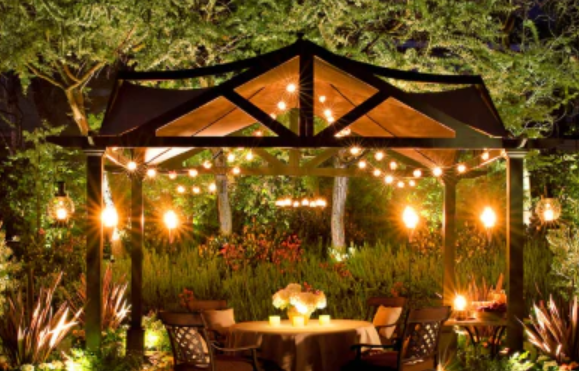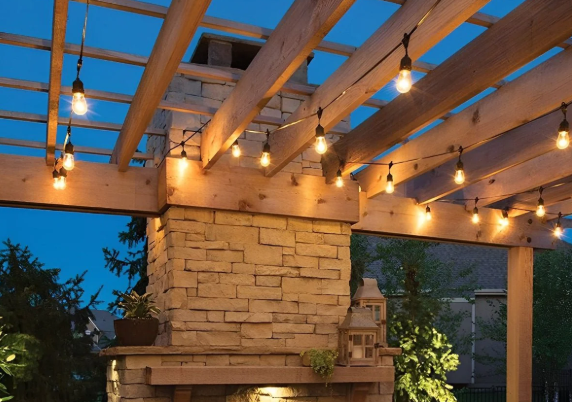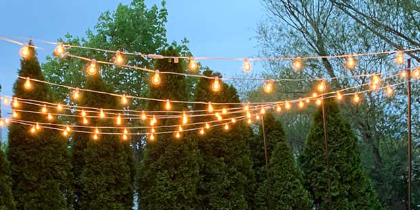Outdoor String Lights Explained: Construction, Manufacturing, Types, Applications & Certifications
The global outdoor string lights market reached $2.3 billion in 2024, with LED variants capturing 78% of total sales according to industry analysis. This dramatic shift from traditional incandescent to energy-efficient LED technology has transformed both residential and commercial lighting applications. Modern outdoor string lights now combine weatherproof construction with smart connectivity features, offering homeowners and businesses unprecedented control over their outdoor ambiance while reducing energy consumption by up to 85%.

Outdoor string lights are decorative lighting systems consisting of multiple light sources connected along a weather-resistant cable, designed specifically for exterior use in residential, commercial, and industrial settings. These versatile lighting solutions feature specialized construction including UV-resistant materials, waterproof sockets rated IP65 or higher, and durable bulb housings that withstand temperatures from -40°F to 140°F, making them suitable for year-round outdoor installation across diverse climates.
Outdoor String Lights Construction and Core Components
The construction of outdoor string lights involves sophisticated engineering to ensure durability, safety, and aesthetic appeal. Modern manufacturing processes integrate multiple protective layers and specialized materials that distinguish outdoor-rated products from their indoor counterparts.

Wire and Cable Architecture
Professional-grade outdoor string lights utilize multi-layered cable construction featuring copper conductors wrapped in thermoplastic insulation. The wire gauge typically ranges from 18 AWG for lighter residential applications to 14 AWG for commercial installations. Heavy-duty SJTW (Service Junior Thermoplastic Weather-resistant) cables incorporate a specialized rubber compound that remains flexible at -40°F while resisting UV degradation, oil, and chemical exposure. The outer jacket thickness measures 30-45 mils, providing mechanical protection against abrasion and environmental stress.
Commercial-grade cords feature stranded copper conductors rather than solid wire, allowing greater flexibility and resistance to metal fatigue. Each conductor strand undergoes tin-plating to prevent oxidation, while the insulation layer uses specially formulated PVC or rubber compounds rated for 600V applications. The cable assembly includes integrated strain reliefs at 24-48 inch intervals, preventing socket displacement under tension loads up to 30 pounds.
Socket and Connection Systems
Weather-resistant sockets represent the critical waterproofing element in outdoor string light construction. Professional-grade sockets feature compression-molded thermoplastic bodies with integrated gaskets achieving IP65 waterproof ratings. The socket design incorporates a triple-seal system: a primary O-ring where the bulb meets the socket, a secondary gasket at the wire entry point, and a tertiary seal created by the socket’s tapered threads.
E26/E27 medium base sockets dominate the commercial market, accommodating bulbs from 5 to 25 watts. The contact points utilize phosphor bronze springs rated for 50,000 insertion cycles, maintaining consistent electrical connection despite repeated bulb changes. Advanced socket designs include drainage channels that prevent water accumulation while maintaining the waterproof seal integrity. Temperature-resistant materials withstand continuous operation at 105°C, exceeding UL requirements by 25%.
Bulb Housing Technologies
Modern outdoor string light bulbs employ shatterproof polycarbonate or acrylic shells rated for 5,000 hours of UV exposure without yellowing or cracking. These materials offer impact resistance exceeding 20 foot-pounds, surviving drops onto concrete from 10-foot heights. The lens design incorporates prismatic patterns that maximize light distribution while minimizing glare, achieving 270-degree beam angles for optimal coverage.
LED modules within bulbs feature aluminum heat sinks that dissipate thermal energy, maintaining junction temperatures below 85°C for extended lifespan. Premium products utilize COB (Chip-on-Board) LED technology, integrating multiple diodes on a single substrate for uniform light output and improved color rendering index (CRI) values exceeding 90. The internal driver circuits include surge protection up to 2.5kV, protecting against voltage spikes common in outdoor electrical systems.
Outdoor String Lights Manufacturing Processes and Quality Control
The manufacturing of outdoor string lights involves precision automation combined with rigorous quality assurance protocols. Modern production facilities employ ISO 9001:2015 certified processes ensuring consistent product quality across millions of units annually.

Assembly Line Production
Automated wire cutting and stripping machines process cable at rates exceeding 200 feet per minute, maintaining tolerance of ±0.5mm for strip lengths. Ultrasonic welding systems join conductors to socket terminals, creating molecular bonds stronger than the base materials. Each connection point undergoes automated pull testing at 15 pounds force, exceeding UL requirements by 50%.
Socket injection molding utilizes multi-cavity tools producing 16-32 sockets simultaneously, with cycle times under 20 seconds. The molding process maintains dimensional tolerances of ±0.002 inches, ensuring consistent thread engagement and gasket compression. In-line vision systems inspect 100% of sockets for defects including short shots, flash, and dimensional variations.
Robotic assembly stations install sockets onto cables at predetermined spacing, applying precise torque values between 8-12 inch-pounds. Automated testing equipment performs continuity checks, insulation resistance measurements at 1500V DC, and ground fault detection on every completed string. Production lines achieve throughput rates of 500-800 complete strings per shift while maintaining defect rates below 0.1%.
Testing and Certification Standards
Comprehensive testing protocols validate outdoor string lights against international safety and performance standards. Environmental testing includes 1000-hour salt spray exposure per ASTM B117, temperature cycling from -40°C to +85°C, and UV resistance testing equivalent to 5 years of outdoor exposure. Products undergo certification through recognized testing laboratories including UL (Underwriters Laboratories), ETL (Electrical Testing Laboratories), and CE marking for European compliance.
Electrical safety testing encompasses dielectric withstand tests at 1500V AC for one minute, ground continuity verification at 25 amps, and leakage current measurements below 0.5mA. Mechanical testing includes strain relief pull tests at 35 pounds for 60 seconds, impact testing per IEC 60068-2-75, and vibration resistance testing simulating transportation and wind loads.
Outdoor String Lights Types and Specifications
The outdoor string light market offers diverse options tailored to specific applications, aesthetic preferences, and performance requirements. Understanding the technical distinctions enables informed selection for optimal results.

LED Technology Variants
Modern LED outdoor string lights achieve energy efficiency ratings of 90-100 lumens per watt, compared to 10-15 lumens per watt for incandescent alternatives. Filament LED bulbs recreate vintage Edison aesthetics while consuming 85% less energy, featuring linear COB strips that mimic traditional tungsten filaments. These designs achieve 360-degree light distribution with color temperatures ranging from 2200K ultra-warm to 5000K daylight.
SMD (Surface Mount Device) LED string lights integrate chips directly onto circuit boards within each bulb, enabling RGB color-changing capabilities with 16 million color combinations. Advanced models incorporate individually addressable LEDs supporting programmable effects including fading, chasing, and synchronized patterns. The control systems utilize PWM (Pulse Width Modulation) dimming at frequencies above 1000Hz, eliminating visible flicker while providing 0-100% brightness adjustment.
Commercial Grade Classifications
Commercial grade outdoor string lights feature heavy-duty construction with weatherproof sockets and wire gauges between 14-16 AWG, designed for permanent outdoor installation in restaurants, patios, and event spaces. These professional specifications support maximum runs of 1200 watts compared to 420 watts for residential grade alternatives. The enhanced current capacity enables connecting up to 20 strings end-to-end for large-scale installations.
Heavy-duty commercial variants incorporate suspended socket designs where each bulb hangs 6-8 inches below the main cable on flexible leads. This configuration reduces wind loading on the primary support cable while allowing individual bulb replacement without system disassembly. Marine-grade versions feature stainless steel hardware and silicone gaskets rated for salt water exposure, meeting IP67 submersion standards for dock and coastal applications.
Smart and Solar Options
WiFi-enabled outdoor string lights integrate with home automation systems supporting voice control through Alexa, Google Assistant, and Siri. The embedded microcontrollers feature 802.11 b/g/n connectivity with WPA2 encryption, enabling remote operation from anywhere via smartphone apps. Advanced features include scheduling, sunrise/sunset automation, music synchronization, and integration with weather services for responsive lighting adjustments.
Solar-powered string lights incorporate monocrystalline silicon panels achieving 22% conversion efficiency, charging integrated lithium batteries ranging from 2000-4000mAh capacity. The charge controllers include MPPT (Maximum Power Point Tracking) technology optimizing energy harvest even in partial shade conditions. Premium models feature dual power systems combining solar charging with USB backup, ensuring reliable operation during extended cloudy periods.
Outdoor String lights Application Categories
The Outdoor string lights serve diverse applications across residential, commercial, and specialty environments, each requiring specific performance characteristics and installation considerations.

Residential Patio and Garden
Patio string lights have become essential for creating inviting outdoor living spaces, with homeowners installing them around pergolas, decks, and garden areas to extend usable hours after sunset. Typical residential installations utilize 24-100 foot strings with 12-24 inch bulb spacing, providing ambient lighting levels of 5-10 foot-candles suitable for dining and conversation.
Garden installations often incorporate low-voltage systems operating at 12-24V DC through landscape transformers, enhancing safety around water features and eliminating shock hazards. Deck string lights frequently feature clips or magnetic attachments for non-invasive mounting on metal railings, while fence-mounted applications utilize coaxial staples sized to match wire diameter without compression damage.
Commercial and Hospitality
Restaurant patios and outdoor dining areas typically specify commercial-grade string lights with minimum 50,000-hour LED lifespans to minimize maintenance costs. These installations often exceed 500 linear feet, requiring load calculations to ensure structural supports accommodate combined dead and wind loads. Professional designs incorporate 20% spare capacity for seasonal decorations or event modifications.
Construction string lights serve industrial applications requiring temporary illumination with IP65 waterproof ratings and impact-resistant housings, supporting job site safety with brightness levels of 12,000-16,000 lumens per 10-bulb string. The rugged construction withstands daily handling, equipment vibration, and extreme weather conditions common on active construction sites.
Event and Entertainment
Wedding and special event applications demand versatile lighting systems supporting rapid deployment and removal without damage to venue structures. Tent installations utilize specialized clamps rated for fabric stress without tearing, while ground-supported systems employ weighted bases calculating 40 pounds per 100 square feet of sail area for wind resistance.
Festival and market lighting requires scalable systems supporting distances exceeding 1000 feet with consistent brightness. These applications often specify 14 AWG wiring supporting 15-amp circuits with voltage drop calculations ensuring end-of-run brightness maintains 90% of source levels. Quick-connect systems featuring twist-lock connections reduce setup time while preventing accidental disconnection during events.
Outdoor String Lights Installation Methods and Techniques
Proper installation ensures optimal performance, safety, and longevity of outdoor string light systems. Professional techniques accommodate diverse mounting surfaces and environmental conditions.

Structural Mounting Systems
Permanent installations utilize stainless steel cable systems tensioned to 200-300 pounds, creating invisible support structures for string lights spanning 50-100 feet without intermediate supports. The aircraft cable specification typically includes 1/8-inch 7×19 construction rated for 1700-pound breaking strength with safety factors exceeding 5:1. Turnbuckles allow precision tension adjustment compensating for thermal expansion and cable stretch.
Professional installers recommend maintaining consistent heights at anchor points to achieve uniform draping, with 10-15% slack creating aesthetically pleasing catenary curves. The mounting hardware includes eye bolts rated for 500-pound working loads, installed at maximum 30-degree angles from vertical to minimize lateral forces on structures.
Wood surface mounting employs coaxial staples or screw hooks penetrating minimum 1.5 inches into solid lumber. Masonry installations require 1/4-inch expansion anchors or adhesive anchoring systems rated for 200-pound pullout resistance. The spacing between attachment points follows manufacturer specifications, typically 8-10 feet for standard weight strings or 5-6 feet for heavy commercial grades.
Power Distribution Planning
Electrical load calculations determine circuit requirements based on total connected wattage plus 25% safety margin. Outdoor installations require GFCI protection on all circuits, with dedicated 20-amp circuits supporting approximately 1920 watts at 80% capacity per electrical code. Voltage drop calculations ensure less than 3% loss over cable runs, maintaining consistent brightness across extended installations.
Extension cord specifications match or exceed string light wire gauges, with 12 AWG cords supporting 100-foot runs at 15 amps. Outdoor-rated cords feature SJTW or SOOW designations indicating water resistance, with locking connections preventing accidental disconnection. Cord routing avoids high-traffic areas while maintaining 6-inch minimum clearance from heat sources and sharp edges.
Outdoor String Lights Maintenance and Longevity
Systematic maintenance extends operational lifespan while maintaining safety and performance standards. Professional maintenance protocols address both preventive measures and corrective actions.

Seasonal Care Protocols
Pre-season inspections identify potential failure points before problems develop. Visual examinations check for cracked sockets, damaged insulation, corroded connections, and UV degradation of plastic components. Electrical testing includes continuity verification, ground fault testing, and insulation resistance measurements using digital multimeters.
Off-season storage requires clean, dry conditions preventing moisture accumulation and rodent damage. Strings should be loosely coiled in 18-24 inch diameters avoiding sharp bends that stress conductors. Climate-controlled storage maintains temperatures between 50-80°F, preventing plastic embrittlement and gasket degradation. Silica gel packets or commercial desiccants control humidity below 50% relative.
Annual maintenance includes gasket lubrication using dielectric grease, maintaining waterproof seal integrity. Socket cleaning removes corrosion using electrical contact cleaner, restoring optimal conductivity. Replacement schedules anticipate 10-15% annual bulb failure rates for LED systems, maintaining spare inventory preventing extended outages.
outdoor string lights Safety Standards and Certifications
Comprehensive safety standards govern outdoor string light design, manufacturing, and installation. Understanding certification requirements ensures code compliance and operational safety.

North American Standards
UL 588 Standard for Seasonal and Holiday Decorative Products covers string lights for installations not exceeding 90 days, while permanent installations follow UL 48 Standard for Electric Signs. The testing protocols validate electrical safety, fire resistance, mechanical durability, and weather resistance through standardized procedures.
ETL certification provides equivalent third-party validation following identical test standards. The Nationally Recognized Testing Laboratory (NRTL) designation confirms acceptance by OSHA for workplace safety compliance. Canadian Standards Association (CSA) certification enables cross-border commerce with harmonized North American requirements.
International Compliance
CE marking indicates conformity with European safety directives including Low Voltage Directive 2014/35/EU and Electromagnetic Compatibility Directive 2014/30/EU. RoHS (Restriction of Hazardous Substances) compliance limits lead, mercury, cadmium, and other restricted materials protecting environmental and human health.
IP (Ingress Protection) ratings specify dust and water resistance levels, with IP65 minimum for permanent outdoor installation. The first digit indicates solid particle protection (6 = dust-tight), while the second specifies water resistance (5 = water jets, 7 = temporary immersion). IK ratings define mechanical impact protection, with IK07 resisting 2-joule impacts typical for outdoor applications.
outdoor string lights Market Trends and Innovation
The outdoor string light industry continues evolving with technological advancement and changing consumer preferences driving innovation across residential and commercial segments.
Smart Integration Technologies
Voice-activated control through AI assistants enables hands-free operation adjusting brightness, color, and effects using natural language commands. Geofencing capabilities automatically activate lights when residents approach, while vacation modes simulate occupancy through randomized operation patterns. Integration with weather services adjusts brightness based on ambient conditions and automatically powers down during high winds.
Matter protocol adoption enables cross-platform compatibility between different smart home ecosystems, eliminating proprietary limitations. Thread mesh networking improves reliability through self-healing connections maintaining operation despite individual device failures. Local processing reduces cloud dependence, ensuring continued operation during internet outages while improving response times below 100 milliseconds.
Sustainability Initiatives
Manufacturers increasingly specify recycled materials including post-consumer plastics for bulb housings and reclaimed copper for conductors. Modular designs enable component replacement rather than complete system disposal, reducing electronic waste by 60%. Take-back programs facilitate responsible recycling recovering valuable materials while preventing environmental contamination.
Energy monitoring features track consumption patterns identifying optimization opportunities. Photocell integration automatically adjusts output based on ambient light levels, reducing energy usage 30-40% compared to static operation. Solar integration continues improving with bifacial panels capturing reflected light, increasing energy harvest 15-20% in typical installations.
Frequently Asked Questions
What is the typical lifespan of outdoor LED string lights?
Quality LED outdoor string lights typically operate 25,000-50,000 hours, equivalent to 8-15 years of daily 8-hour usage. The lifespan depends on operating temperature, with each 10°C increase reducing life expectancy by approximately 50%. Premium products featuring enhanced thermal management and quality components achieve the upper range, while budget options may only reach 15,000 hours. Regular maintenance including cleaning and proper storage extends operational life by preventing premature component degradation.
How do I calculate the number of string lights needed for my patio?
Calculate perimeter footage adding 15-20% for draping slack between attachment points. Standard installations use single perimeter runs, while enhanced lighting doubles coverage with parallel strings spaced 8-10 feet apart. For area coverage, plan 100-150 watts of LED lighting per 200 square feet achieving 5-10 foot-candles suitable for dining and entertainment. Consider existing lighting, desired ambiance level, and primary usage patterns when determining optimal density.
Can outdoor string lights remain installed year-round?
Commercial-grade outdoor string lights with IP65 or higher ratings safely remain installed year-round in most climates. Permanent installation requires UV-resistant materials, stainless steel hardware, and proper drainage preventing water accumulation in sockets. Annual inspections should verify gasket integrity, connection tightness, and absence of physical damage. Extreme weather regions experiencing ice storms or hurricanes benefit from seasonal removal preventing catastrophic damage.
What causes outdoor string lights to trip GFCI outlets?
GFCI tripping commonly results from moisture penetration creating ground faults exceeding 5mA threshold. Damaged gaskets, cracked sockets, or compromised wire insulation allow water ingress triggering protection. Multiple strings on single circuits may exhibit cumulative leakage approaching trip levels. Solutions include verifying proper installation angles promoting drainage, replacing worn gaskets, and distributing loads across multiple GFCI-protected circuits.
How do solar string lights perform in cloudy climates?
Modern solar string lights featuring high-efficiency panels and adequate battery capacity operate effectively in partially cloudy conditions. Quality systems with 2W+ panels and 2000mAh+ batteries provide 6-8 hours operation after cloudy days receiving 3-4 hours indirect sunlight. Performance improves with panel positioning optimization, periodic cleaning removing efficiency-reducing debris, and hybrid models incorporating USB charging for extended overcast periods.
What is the difference between commercial and residential grade string lights?
Commercial grade string lights feature 14-16 AWG wire gauges compared to 18 AWG residential versions, supporting longer runs up to 1200 watts versus 420-840 watts. Commercial sockets utilize weatherproof designs with superior gaskets maintaining IP65 ratings through repeated bulb changes. The enhanced specifications justify 2-3x price premiums but provide 5-10 year operational lifespans compared to 2-3 years for residential grades in continuous outdoor use.
Key Takeaways
- Modern outdoor string lights combine weatherproof construction rated IP65 or higher with energy-efficient LED technology reducing consumption by 85%
- Commercial-grade specifications featuring 14-16 AWG wiring and suspended sockets support permanent installation lasting 10+ years
- Professional installation utilizing tensioned cable systems and proper load calculations ensures safety while optimizing aesthetic appeal
- Smart connectivity enables voice control, scheduling, and integration with home automation systems enhancing convenience
- Comprehensive certifications including UL, ETL, and CE validate safety and performance for diverse global applications
